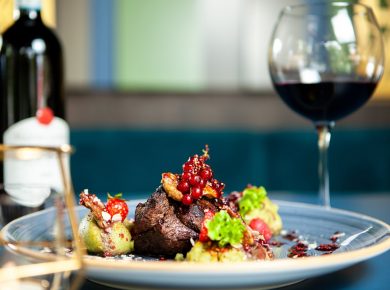When it comes to organising a successful conference, catering plays a crucial role in ensuring attendees are satisfied and energised throughout the event.
In this article we are going to explore the ins and outs of conference catering, providing you with ideas and insights on how to properly cater for your own conference and pull off an event to remember. We’ll also discuss the types of food commonly served at conferences, which foods to avoid, and the highlight importance of catering in creating a positive experience.
Let’s tuck in!
What Is Conference Catering?
Conference catering refers to the provision of food and beverage services during a conference or similar corporate event.
The goal of conference catering is to offer attendees a well-rounded dining experience that complements the conference agenda and ensures their satisfaction.
It involves menu planning, food preparation, presentation, and service coordination to meet the specific needs and preferences of all your conference attendees.
Corporate events and conferences can err on the side of tedium, so it is important that you feed your guests well!

How Do You Cater for a Conference?
So, how do you properly cater for a conference? Are there any tricks to pulling it off without a hitch? Here are some things to bear in mind:
- Start by understanding the event: Consider the conference theme, duration, number of attendees, and dietary preferences and/or restrictions.
- Collaborate with a professional caterer: Find a reputable caterer experienced in conference catering to ensure a seamless and high-quality service.
- Customise the menu:
- Offer a variety of options: Create a diverse menu with vegetarian, vegan, gluten-free, and allergen-friendly choices to accommodate different dietary needs. Great value conference catering is inclusive for everyone.
- Consider meal timings: Plan meals and breaks strategically to align with the conference schedule, ensuring attendees have sufficient time to dine – and are able to remain focused throughout the event.
- Opt for easy-to-eat foods: Choose foods that can be consumed easily while networking or attending sessions, such as finger foods, mini sandwiches, or individually portioned meals.
- Provide beverage options: Offer a selection of beverages, including water, juices, coffee, and tea, to keep attendees hydrated and refreshed.
- Pay attention to presentation: Present the food in an appealing and visually enticing manner to enhance the dining experience.

What Food Is Served at a Conference?
Now let’s talk about what types of food are typically served at a conference. The following ideas should fill you with some inspiration:
- Breakfast options:
- Continental breakfast: Assortment of pastries, fruits, yogurt, and cereals.
- Hot breakfast: Scrambled eggs, bacon, sausages, roasted potatoes, and breakfast slices of bread.
- Lunch and dinner options:
- Buffet-style meals: A variety of hot and cold dishes, including salads, proteins (chicken, fish, beef), vegetarian options, and side dishes.
- Boxed lunches: Pre-packaged meals with sandwiches or wraps, salads, fruits, and desserts.
- Action stations: Live cooking stations offering made-to-order dishes, such as pasta, stir-fry, or carving stations.
- Snacks and refreshments:
- Assorted finger foods: Mini sandwiches, sliders, wraps, spring rolls, and bite-sized appetisers.
- Fresh fruit platters, vegetable crudité, and cheese and charcuterie boards.
- Energy bars, cookies, and other sweet treats.
- Beverage options:
- Water (both still and sparkling).
- Soft drinks, juices, and iced tea.
- Coffee and tea, including a variety of flavours and options like decaf and herbal teas.
What Foods Should Be Avoided When Catering for a Conference?
More importantly…what types of food should you not serve at a conference? Remember, you want the food to be quick & easy. If your attendees are eating messy, greasy burgers, they’re going to need to go to the bathroom to clean up in between which can cause unnecessary distractions. Consider the following:
- Strong-smelling foods: Foods with strong odours, such as garlic, onions, or certain spices, should be avoided to prevent unpleasant smells that may distract attendees.
- Messy or difficult-to-eat foods: Foods that require utensils or are messy to eat can be inconvenient during a conference. Opt for easy-to-handle finger foods or bite-sized items.
- Common allergens: Be mindful of common allergens, such as nuts, dairy, or gluten, and provide clear labelling for attendees with dietary restrictions or allergies.

Why Is Catering So Important at a Conference? What Are the Benefits?
Is food really that important for a conference? What’s all the fuss about? These following benefits may change the way you perceive conference catering:
- Enhances attendee experience: Well-planned catering ensures attendees are well-fed and energised, enhancing their overall conference experience.
- Promotes networking: Appetising food and beverage options creates a relaxed atmosphere, encouraging networking and collaboration among attendees.
- Reflects the event’s professionalism: High-quality catering demonstrates attention to detail and professionalism, leaving a positive impression on attendees.
- Supports productivity: Providing nourishing meals and snacks helps sustain attendees’ energy levels, allowing them to stay focused and engaged throughout the conference.
- Boosts attendee satisfaction: A satisfying culinary experience contributes to overall attendee satisfaction and increases the likelihood of positive feedback and future attendance.
Conclusion
Conference catering is an integral part of creating a successful and memorable event. By understanding the needs and preferences of attendees, customising the menu, and collaborating with a professional caterer, you can provide a delightful dining experience that complements the conference agenda.
From breakfast options to lunch and dinner choices, as well as snacks and beverages, a well-planned catering service will keep attendees satisfied and energised throughout the day.
Remember, by avoiding strong-smelling or messy foods and catering to dietary restrictions and allergies, you’ll be ensuring inclusivity and attendee comfort.
We hope that you’ve found this article to be insightful and wish you the very best of luck with putting on your corporate conference and keeping your guests well-fed and entertained!










